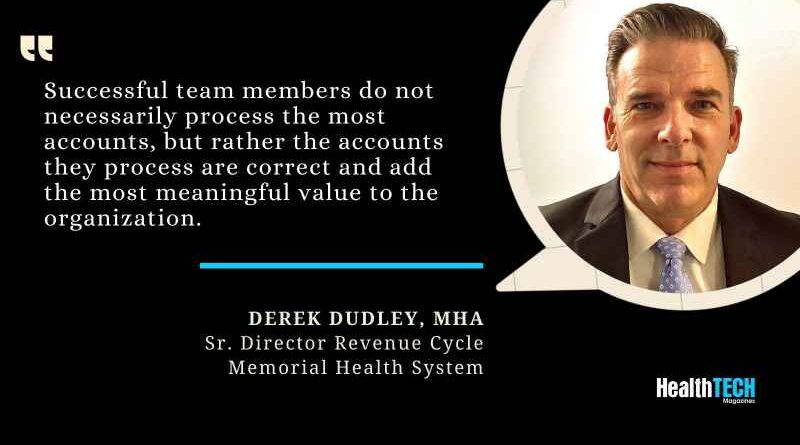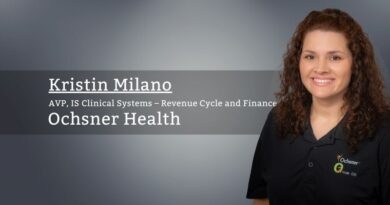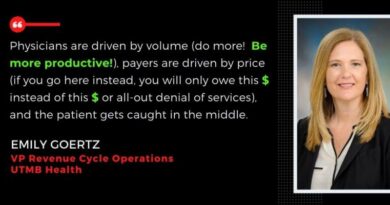Stop looking to productivity, start looking for effectiveness
By Derek Dudley, MHA, Sr. Director Revenue Cycle, Memorial Health System
Prior to the onset of the current pandemic which has forced many of us to pivot to a remote workforce, we at Memorial Health System already had a large portion of our staff working remotely. The challenge was that we really had no way to understand how effective our team members’ actions were. As an institution, we had chosen to send team members home in 2017 and had been doing a marginal job of managing up performance due to the lack of tools and technology. In the fall of 2019, we determined that the current approach was not working, and we needed a better way to move towards best in class performance. We were not ready to abandon our remote strategy, as we felt strongly that it made us a more attractive employer and that it truly is the way forward in our industry, but rather we needed to refine our remote process.
We began our improvement journey with a very manual process of monitoring and managing our team members. During the initial review, it became clear that this was not sustainable, and we realized that to improve our performance, we needed help from other industry thought leaders. As a smaller health system, the large price tag system solutions were not an option and as such, we needed to look for a more innovative approach to how we created solutions for our issues. After consideration, we reached out and partnered with Baker Tilly who put us in contact with VISPA to design and implement a solution that would allow us to transform performance while keeping costs as low as possible. VISPA had worked with subject matter experts at Baker Tilly to develop a work tasking system that would present the next most valuable account to the next available user, like calls in an ACD system. No longer would team members have to work from a singularly assigned queue, but rather many could share in the work. This would allow my leadership team to deliver the work based on business rules and not user preference. This ability to shape work priority and delivery now let us drive tasks to team members based on the priority we set for accounts to be worked. Since we went live on VISPA, all team members are working on what we have determined as the most valuable accounts, which has driven up our team members’ contribution margins.
As an additional benefit to the change in our approach, we have also found that through a more modern and robust analytics platform, we are able to coach team members towards the most appropriate resolutions. We are now able to see what is working and what is not and provide micro training with specific topics for each team member on particular issues instead of large group training in which only a few will benefit.
The biggest change came in how we defined team member success. No longer will simply touching 65 accounts per day mean that the team member is successful, but rather we are now looking at the effectiveness of each team members’ actions and using that as a measure of success. For example, if team member 1 touches 28 accounts and all actions taken result in successful processing, that team members’ actions are more valuable than those of team member 2 who touches 50 accounts with a 50% effectiveness rate. We also now able to see the financial contribution of each team members’ actions. Successful team members do not necessarily process the most accounts, but rather the accounts they process are correct and add the most meaningful value to the organization. Productivity is no longer the sole measure of success, but we now look at the effectiveness and contribution margin to really indicate the effectiveness of each team members’ actions.
As we wrapped up implementation in early March, COVID began to effect how we viewed working on-site. We were forced to face the reality that we needed to send more team members home to ensure their safety. We were able to pivot to almost a total remote workforce with relatively little adverse effects on our staff performance. As we are now six months into COVID and our project, we have seen improved results in both overall team member effectiveness and contribution margin.
As we moved through this journey, we took great care to not “pave our goat paths”, that is to say, we did not want to automate an existing bad or broken process as that would just mean we arrived at poor results quicker. Instead, we looked at our processes in depth to ensure we found the leanest and most direct route to account resolution. Once we had straightened out our “goat paths”, we could then begin to engage technological solutions aimed at improving efficiency. Often our industry is quick to jump on the next shiny new bit of high tech wizardry promised to deliver outstanding results, and when we do not see the ROI, we are left scratching our heads as to why. By beginning with process review, we were able to avoid some of the pitfalls often associated with deploying these types of system solutions.
As we continue to evolve the technology, we are beginning to apply Robotic Processing Automation to areas like account status checks, pre-certification, prior authorization, eligibility, underpayment discovery, and documentation requests. We expect to continue to realize improvements in team member effectiveness, as well as contribution margin, as we are able to remove basic low-level tasks from those that team members must process and allow them to focus on those specific accounts that need special handling.
While having leading-edge tools and streamlined processes have produced significant results, we know that as a leadership team, we cannot rest. In order to really change the way work is performed in healthcare, the greatest challenge will be to keep an open mind to the future possibilities and not limit ourselves to the organization by thinking about how work has always been done. We need to remember that all growth comes when we stretch just outside of our comfort zone and push against the boundaries of the possible.



